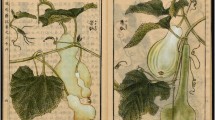Abstract
Tulips: An Ornamental Crop in the Andalusian Middle Ages. The authors are working on the project “Crop Flora of al-Andalus,” which aims to recover the crop diversity of the Middle Ages in western Europe during the Islamic period. The documental sources of this study are all the agricultural treatises written in this territory and culture between the 10th and 14th centuries. Al-Andalus was the territory occupied by Islam between the 8th and 15th centuries, varying over time on varying regions on the Iberian Peninsula. In this period, a genuine agricultural revolution took place, as well as the incorporation into the Western world of many Eastern agricultural species. When we focused on the study of ornamental species used in gardens, courtyards, and houses, tulips could be identified in several texts, the main one being the ‘Umda, a botanical work written at the end of the 11th century or beginning of the 12th, probably by the agronomist Abu l-Jayr. Tulips are mentioned in this text 500 years before the first known references to their introduction into Europe, traditionally asserted to be from the Ottoman Empire to Holland via Austria, always in the 16th century. Thus the route of these ornamental bulbs in their passage from East to West must be modified.
Similar content being viewed by others

Literature Cited
Abu l-Jayr. 1991. Kitab al-filaha. Tratado de Agricultura. J. Ma Carabaza Bravo, ed. and translator. Instituto de Cooperación con el Mundo Árabe, Madrid.
———. 2004, 2007 ´Umdat al-tabib fi ma´rifat al-nabat (Fundamental Book for a Doctor to Acquire a Knowledge of Botany). 2 vols. J. Bustamante, F. Corriente, and M. Tilmatine, eds. and translators. Vol. I (ed.), Vol. II (trans.). Consejo Superior de Investigaciones Cientificas, Madrid.
Al-Himyari, A. W. 1940. Al-Badi` fi wasf al-radi`a (Marvels in the Description of Spring). H. Pérès, ed. Imprimerie Economique, Rabat, Morocco.
Al-Tignari. 2006. Zuhrat al-bustan wa-nuzhat al-adhan (Garden Splendor and the Pleasures of the Spirit). E. García-Sánchez, ed. Consejo Superior de Investigaciones Cientificas, Madrid.
Anonymous. 1990. Kitab fi tartib awqat al-girasa wa-l-magrusat. Un tratado agrícola andalusí anónimo. A. López, ed. and translator. Consejo Superior de Investigaciones Cientificas, Madrid.
´Arib b. Sa´id. 1961. Le Calendrier de Cordoue (Calendar of Cordova). Ch. Pellat, ed. and translator. E-J. Brill, Leiden.
Besler, B. 1613. Hortus Eystettensis sive Diligens et accurata omnium plantarum, florum, stirpium ex variis orbis terrae partibus singulari studio collectarum, quae in celeberrimis viridiariis arcem episcopalem ibidem cingentibus hoc tempore conspiciuntur. 2 t. Nuremberg.
Carabaza, J. Ma, E. García-Sánchez, J. E. Hernández-Bermejo, and A. Jiménez-Ramírez. 2004. Árboles y Arbustos de al-Andalus. CSIC, Madrid.
de los Ríos, G. 1991. A Propósito de la Agricultura de Jardines de Gregorio de los Ríos. J. Fernández Pérez and I. González Tascón, eds. (Reproduction of facsimile edition, Madrid 1620). Real Jardín Botánico and Ayuntamiento de Madrid, Madrid.
Dodoens, R. 1568. Florum et Coronarium Odoratumque Nonnularum. Antwerp.
García-Sánchez, E. 2007. Los jardines de al-Andalus y Sicilia, punto de encuentro y difusión de nuevas especies y técnicas. Supplement to Architettura del Paesaggio 16 (on CD).
——— and J. E. Hernández-Bermejo. 2007. Ornamental Plants in Agricultural and Botanical Treatises from Al-Andalus. Pages 75–94 in M. Conan, ed., Middle East Garden Traditions: Unity and Diversity. Dumbarton Oaks Research Library and Collection, Harvard University Press, Washington, D.C.
Gerard, J. 1597. Herball. London.
Gessner, C. 1561. Valeri Cordii Simesusii annotationes in Pedaci Dioscorides Anazerbei de materia medica libros V.. Item Conrado Gessneri de Hortis Germaniae.. cum descriptione Tulipae Turcarum.. Strasbourg.
González-Ferrín, E. 2006. Historia General de al-Andalus. Almuzara, Córdoba, Spain.
Hernández-Bermejo, J. E. 1987. Aproximación al Estudio de las Especies Botánicas Originariamente Existentes en los Jardines de Madinat al-Zahra. Cuadernos de Madinat al-Zahra I:61–80.
———. 1991. Botanical Foundations for the Restoration of Spanish Arabic Gardens: Study of the Plant Species Used and Their Introduction during the Andalusi Period. Pages 153–164 in J. Tjon Sie Fat and E. de Jong, eds., The Authentic Garden. Clusius Foundation, Leiden.
——— and E. García-Sánchez. 1998. Economic Botany and Ethnobotany in al-Andalus (Iberian Peninsula: Tenth–Fifteenth Centuries), an Unknown. Heritage of Mankind. Economic Botany 52:15–26.
Ibn al-´Awwam. 1988. Kitab al-Filaha. Libro de Agricultura, 2 vol. J. A. Banqueri, ed. and translator, 1802, Madrid. (Facsimile edition with preliminary study and notes by J. E. Hernández-Bermejo and E. García-Sánchez). Ministry of Agriculture, Madrid.
Ibn Bassal. 1995. Kitab al-qasd wa-l-bayan. Libro de agricultura. J. M. Millás Vallicrosa and M. Aziman, eds. and translators. (Facsimile of edition Tetuan, 1955, with a preliminary study and notes by E. García-Sánchez and J. E. Hernández-Bermejo). El Legado Andalusí, Granada.
Ibn Luyun. 1975. Kitab ibda’ al-malaha wa-inha’ al-rayaha. Tratado de agricultura. J. Eguaras, ed. and translator. Patronato de la Alhambra y Generalife, Granada.
Lobelius, M. 1576. Plantarum seu Stirpium Historia. Antwerp.
Martín-Consuegra, E., J. E. Hernández-Bermejo, and J. L. Ubera. 1995. Palinology of the Historical Period at the Madinat al-Zahra Archaeological Site, Spain. Journal of Archaeological Science 23(2)249–262.
Pavord, A. 1999. The Tulip. Bloomsbury Publishers, London.
Ramón-Laca, L. and R. Morales. 2005. L’Écluse de Arras, Ch. (1576, Rariorum aliquot stirpium per Hispanias observatarum historia). Junta de Castilla y León.
Wijnands, D. O. 1991. Commercium Botanicum: The Diffusion of Plants in the 16th Century. Pages 74–85 in J. Tjon Sie Fat and E. de Jong, eds., The Authentic Garden. Clusius Foundation, Leiden.
Author information
Authors and Affiliations
Corresponding author
Rights and permissions
About this article
Cite this article
Hernández Bermejo, J.E., García Sánchez, E. Tulips: An Ornamental Crop in the Andalusian Middle Ages. Econ Bot 63, 60–66 (2009). https://doi.org/10.1007/s12231-008-9070-3
Received:
Accepted:
Published:
Issue Date:
DOI: https://doi.org/10.1007/s12231-008-9070-3



